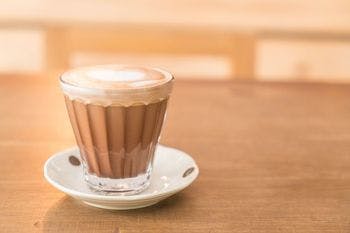
Cortado vs Flat White: 15 Major Differences to Know

Picture this: You step into your favorite coffee shop, eager for that perfect cup of coffee. But then, you're perplexed to choose between Cortado and Flat White? Both of these coffee beverages sound delicious, but what sets them apart?
It can be a bit confusing to make a choice with all beverages having fancy names, right? Don't worry!
Today, I'm here to guide you with the complete details about Cortado and Flat White. These two most loved coffee beverages are like siblings; they share certain qualities but have their own unique characteristics too.
I'll break it down for you with a step-by-step guide and explain how you can brew them, and the differences between them and, by the end of this blog, you'll know which one will suit your taste preferences.
Whether you're a barista, a homebrewer, or an enthusiast interested in knowing more about coffee, this blog is your guide to Cortado and Flat White. So, let's dive in.
Cortado: Overview
What is cortado?
The Cortado, a delightful coffee creation, is a name that rolls off the tongue as smoothly as the brew itself. The word "Cortado" has its origins in Spanish, where it means "cut." It's a perfect name because this coffee is basically an espresso "cut" with a small amount of warm milk.
The Cortado is often enjoyed as a morning or afternoon pick-me-up. It's a beverage loved by coffee lovers who crave a balance between the robustness of espresso and the creaminess of milk.
The heart of a Cortado lies in its foundational shot of espresso. This is where the magic starts. The espresso shot is extracted with care, ensuring that it yields the rich, bold flavors that are a hallmark of quality coffee. It's the foundation upon which the Cortado is built.
To make this enchanting brew, the barista uses a ratio of 1:1 and blends the 1.5–2 ounce espresso shot with an equal or slightly larger quantity of warm milk, often steamed to around 150–160°F (65–70°C). The result is a coffee with a velvety texture, where the milk "cuts" the sharpness of the espresso, crafting a harmonious and balanced flavor profile.
A Cortado is not just a drink; it's an experience. It's neither as concentrated as an espresso nor as diluted as a latte and clearly hits that sweet spot with its rich taste. It's generally served in a small, usually 4-6-ounce glass or cup, which makes it the ideal size for sipping slowly and savoring every drop.
How to make a Cortado?
Step 1: Prepare your espresso.
Begin by grinding your espresso beans to a fine consistency. Add the right amount of coffee grounds to your portafilter and tamp it evenly. Insert the portafilter into your espresso machine and begin the extraction process. A single espresso shot would be enough. Make sure it has a rich, golden crema on top.
Step 2: Steam the milk.
In a separate container, heat your milk at 150–160°F (65–70°C). You can use a thermometer to check the temperature. Position the steam wand just under the milk's surface and froth it until it has a rich, creamy texture but is not dense. The ideal texture is velvety microfoam, smooth and free from any large bubbles.
Step 3: Combine espresso and milk.
In a small glass or cup, pour your fine espresso shot. Now, to cut the bitterness of the espresso, add an equal or slightly larger amount of steamed milk. The milk is added to mellow the intensity of the espresso without overpowering it.
You have your delicious Cortado ready.
Serve it in a traditional small glass or cup that can hold around 4-6 ounces.
Flat White: Overview
What is a Flat White?
The origin of the Flat White is a subject of friendly debate between Australia and New Zealand, with both nations claiming their stake in this coffee masterpiece. It's believed to have emerged in the 1980s, originating from the Antipodean coffee culture.
The name "Flat White" refers to the drink's creamy texture. The base of a Flat White is a beautifully pulled shot of espresso. Make sure the espresso extracted is strong, aromatic, and flavorful.
The Flat White is prepared with a fine blend of espresso shot and micro-foamed milk. The result is a harmonious blend where the milk enhances the espresso's rich flavors using the golden espresso-to-milk ratio of 1:2 or 1:3.
A Flat White is traditionally served in a smaller cup, typically around 5–6 ounces. It's a reminder that in every cup, there's a story waiting to be explored.
How to make a Flat White?
Step 1: Pull the espresso shot.
Take some espresso beans and grind them to a fine consistency. Add some coffee grounds to your portafilter. Make use of the tamper to create a flat bed of grounds in the portafilter. Once done, insert the portafilter into your espresso machine and begin the extraction process. Pull a double espresso shot (around 2 ounces or 60 ml).
Step 2: Steam the milk.
While your espresso is prepared, start steaming the milk. For this, fill your stainless steel milk pitcher with cold milk; the one-third amount would be good to go, leaving the space for milk to expand during steaming. Immerse the steam wand just below the milk's surface and turn it on.
Make sure you place the steam wand off-center to create a whirlpool effect in the milk. Steam it at a temperature of 150–160°F (65–70°C). Place a thermometer inside to monitor the temperature. Stop once you attain the creamy, velvety texture.
Step 3: Combine espresso and milk.
Once you have your espresso shot ready, pour it into a coffee cup. Now gently pour the steamed milk into the espresso and create a signature "white dot" on the surface of the coffee.
Your Flat white is ready. Sip it with some cheesecake or blueberry muffins.
Get all-in-one espresso brewing accessories from HERE.
Cortado vs. Flat White: Quick Comparison
The main difference between cortado and flat white is that a cortado is a coffee drink made with equal parts espresso and steamed milk. On the other hand, a Flat White is made with a double shot of espresso and a thin layer of velvety steamed milk.
1) Appearance
While Cortado and Flat White might look similar, on closer observation, you will see a clear difference. A Cortado is typically presented in a smaller glass, highlighting its concentrated beauty, while a Flat White comes in a larger cup, allowing more room for the coffee's rich and velvety texture.
2) Origin
Cortado has its origins in Spain, where the word "cortar" signifies "to cut." It's a reference to the espresso being "cut" or diluted with some warm milk. On the other hand, Flat White has a disputed origin between Australia and New Zealand, with both countries claiming their stake.
3) Composition
Cortado is a simple blend of espresso and warm milk, creating a balanced and straightforward flavor while the Flat White is a combination of espresso and microfoamed milk, yielding a more luxurious and velvety experience.
4) Texture
When considering texture, Cortado has a smoother, lighter texture somewhat like traditional coffee, whereas Flat White is rich and creamy in texture due to the microfoaming of the milk, which gives it a more sophisticated feel.
5) Milk type
You can generally use whole milk for both beverages, but Flat White's microfoam milk yields a creamier texture as compared to the warm milk used in a Cortado.
6) Size
Cortados generally have a modest size, typically around 4-6 ounces. In contrast, Flat Whites come in larger cups, usually around 5–6 ounces, giving a more substantial coffee experience.
7) Flavor
Cortados have a straightforward and balanced flavor profile, while Flat Whites have a pretty complex and well-rounded taste due to the addition of micro-foamed milk.
8) Customization
Both drinks are completely customizable. You can try different ingredients as per your preferences. It can be any syrup or sweetener.
9) Strength
Cortados have a stronger coffee flavor, which is liked by coffee lovers who enjoy a rich, concentrated flavor profile, whereas Flat Whites strike a balance between espresso boldness and milk creaminess with the addition of foamed milk.
10) Coffee-to-water ratio
Cortado's espresso shot is "cut" with a small amount of milk, creating a denser coffee with a ratio of 1:1, while Flat White balances espresso and micro-foamed milk for a creamier taste with its 1:2 espresso-to-milk ratio.
11) Serving size
Considering serving sizes, Cortado is served in smaller glasses, making it easier to sip and savor, whereas Flat Whites come in larger cups, offering a comforting coffee experience.
12) Milk temperature
The milk used to prepare a Cortado is warmed but not normally microfoamed, while in Flat White, the milk is steamed well to create a velvety microfoam.
13) Microfoam
The Flat White uses microfoam milk, which contributes to its rich and creamy texture and sets it apart from the smoother texture of a Cortado.
14) Caffeine content
Cortados and Flat Whites both can have varying caffeine content based on the espresso-to-milk ratio used. But generally, both have similar caffeine content which is around 128 mg.
15) Things needed
For the preparation of Cortado, you will need an espresso machine, espresso beans, a tamper, a scale, and milk. While for Flat White, you will require an espresso machine, espresso beans, a tamper, a scale, and a steaming machine.
Wrapping up
Here, I have got you covered with the comparison between cortado vs flat white. Both coffee beverages have their own unique characteristics, and choosing between them narrows down to one's personal preference.
The Cortado, with its simple composition and balanced flavor, offers a no-fuss coffee experience that many find appealing. On the other hand, Flat White, with its velvety microfoam and harmonious blend of espresso and milk, provides a more indulgent and complex coffee adventure.
You can try a Cortado when you crave a straightforward coffee experience, and then brew a Flat White when you're in the mood for something more luxurious. Try them using different beans, milk types, and flavor additions to tailor these drinks to your unique taste, and share your coffee experience with us.

I am a barista by profession hailing from NC. My journey began in my late teens when I started working as a barista in a local coffee shop. My passion for coffee quickly became evident as I immersed myself in the art of espresso extraction, latte art ...



